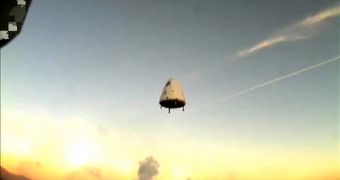Billionaire Jeff Bezos, of Amazon.com fame, is currently involved in constructing a new spacecraft, which is designed to be capable of routinely flying numerous astronauts to suborbital flights, at very low prices. The Bezos Blue Origin business plan is currently undergoing testings at a private launch site in Texas, which is also funded by the billionaire. From what was made transparent, the design is that of capsule with vertical landing and take-off capabilities. This design differs from others set up for suborbital flights, Space reports.
It rather resembles NASA's designs for the prototype aircraft which it wishes to send back on the Moon. Bezos' team apparently drew from that influence. However, there is no way of telling precisely what specifications we're dealing with here, as the entrepreneur is keeping the designs under wraps. All that was revealed is that this is an Origin-class suborbital craft, which would be capable of routine suborbital flights. The approach varies significantly from that taken by The Spaceship Company, which operates SpaceShipTwo, also a private suborbital spacecraft.
Blue Origin recently announced that it has selected three new scientific payloads to fly on the spacecraft, which has been dubbed New Shepard. One of them is Purdue University's Three-Dimensional Critical Wetting Experiment in Microgravity, the second is the University of Central Florida's Microgravity Experiment on Dust Environments in Astrophysics (MEDEA), while the third is the Effective lnterfacial Tension lnduced Convection (EITIC), managed by experts at the Louisiana State University. “These payloads were selected from an excellent field of submitted proposals,” explains a statement on the Blue Origin website.
The testing stage for the New Shepard suborbital vehicle began as early 2006, but the company says that it won't be until 2011 that the first autonomous flights will be conducted. Even then, scientific experiments will be carried into orbit aboard an unmanned aircraft. After those tests end, a few years from now, passengers will finally be ferried to orbit themselves. Launches will take place from West Texas, where a dedicated launch site has already been constructed.

 14 DAY TRIAL //
14 DAY TRIAL //